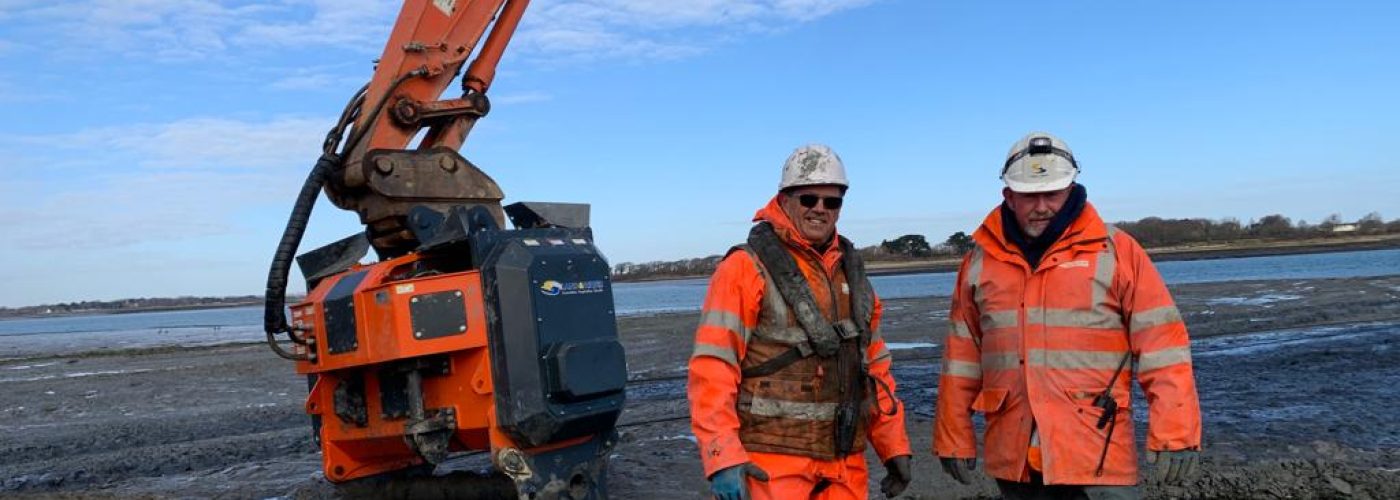60% of the Saltmarsh habitats around the UK have been lost since 1945, and without some inspired interventions significant further losses will continue, fuelled by coastal squeeze (development), increased wash from boats, extreme climatic events (climate change influences) and rising sea levels.
Leading wet civil engineering firm, Land & Water, alongside the new sister company Earth Change, (which was set up to optimise the natural capital solutions for distressed land), has re-invented a drag box solution dating back to the early 1900s to restore the UK’s Saltmarshes, with the first full-scale trails, permitted by the MMO (Marine Maritime Organisation), completed in March 2023.

Saltmarshes provide incredible environmental benefits including acting as a natural flood defence, an absorbent of harmful nitrates and phosphates and a haven for wildlife to increase biodiversity.
Land & Water, and Earth Change, have partnered with Chichester Harbour Conservancy as part of the Solent Seascape Project for trials to restore the saltmarsh in Chichester Harbour. The need to restore this valuable environment follows the loss of 250ha of Saltmarsh in Chichester alone since 1945.
The UK dredges approximately 20 million tonnes of silt and mud a year maintaining our ports, harbours and marinas. The majority of this material is disposed of offshore, in designated disposal sites. The new technology allows this valuable resource to be reused for an environmental gain, and crucially “at scale”.
Restoring Saltmarshes within an intertidal habitat is not straightforward. The large barges and ships used in commercial dredging operations cannot directly access the shallow waters and mudflats where Saltmarsh proliferates. The use of the drag box enables the larger vessels to deposit their muddy cargoes close to the Saltmarsh at high tide, for retrieval once the tide has ebbed away.
The drag box methodology was used by Victorian engineers to dredge lakes, dragging a skid between two traction engines to recover silts and sediments ashore. Land & Water has borrowed modern hydraulic winching technologies from the Canadian Forestry Industry, coupled with a new/enlarged drag box design to enable the efficient recovery of large quantities of sediment in very short timescales, and with negligible environmental impact. (See below link)
James Maclean, CEO of Land & Water, says “This exciting new development shows how we can reuse materials from one industry in a positive way to increase the value of our nation’s Natural Capital. Our works are being underpinned by a team of national experts and we are delighted to have worked with a wide group of stakeholders to unlock this concept.
“Helping nature to help herself is hugely gratifying and finding an opportunity to provide an alternative beneficial reuse of what is usually a waste material that would previously be disposed of at sea is a truly circular economy concept at work.
“From trials conducted over eight years ago we know we can recolonise the Saltmarsh naturally with carefully crafted new landforms made from the silt, which is a totally natural product. This process provides knock-on benefits to water quality, bio-diversity net gain, reduce coastal erosion, improve sea defences, create green space habitats and carbon fixing… accessing new funds from developers, who can show corporate responsibility by funding nature’s recovery close to their new schemes.”
Chichester Harbour has a very high nature conservation value and is highly protected. But it has also lost nearly 60% of its Saltmarsh since 1946 (established using wartime military aerial photography as highlighted in Natural England’s Condition Review of Chichester Harbour SSSI February 2021). Similarly worrying levels of decline in Saltmarsh have been documented around the Solent, and more widely around the sensitive estuaries of the UK.
The research for the trials will be led by Angus Garbutt at The Centre for Ecology and Hydrology (CEH), and Christian Dunn at Bangor University with Jo Preston at University of Portsmouth. Once finished, it will look to validate the nutrient and carbon uptake of the restored habitat and provide a basis for a new nutrient and carbon code for habitat trading. By validating the carbon and nutrient absorbing capacity of this Natural Capital asset, the credits from the re-creation will be offered to frustrated developers to offset the impacts of their new developments and stimulate nature’s recovery “in their own back yard”.
Tom Godfrey, Co-Founder of Earth Change, commented: “This has proven an incredibly efficient and low carbon method of reusing a material that’s usually deposited at sea to regenerate a failing SSSI Saltmarsh.
“Earth Change is very happy with how the saltmarsh restoration drag-box trial has gone to date. As a result, we have generated interest from other parties to use this method. I would like to thank our partners, Chichester Harbour Conservancy, Blue Marine Foundation, Endangered Landscape Programme and East Head Impact who have helped make this trial possible and to Land & Water who has delivered this innovative solution.”
Sarah Chatfield, CHaPRoN Manager, said: “CHaPRoN is very excited about the saltmarsh restoration project at West Itchenor. It has been a success so far and we look forward to seeing the saltmarsh begin to recolonise over the summer and reviewing the outcomes of the project with our statutory partners. We need to find different ways of working if we are to reverse the declining trend in biodiversity and we hope we can continue with this approach of saltmarsh restoration in Chichester Harbour in the years to come.”
Louise MacCallum, Solent Project Manager of Blue Marine Foundation, said: “It’s so inspiring to see the Solent Seascape Project being kicked off with such an innovative model to restore saltmarsh in one of the Solent’s most beautiful harbours. I am looking forward to revisiting the site in the months and years to come to watch its colonisation by saltmarsh plants.”
Land & Water and Earth Change are set to undertake similar, full-scale trials at Lymington Harbour during the summer.
For more information about the trials at Chichester Harbour, please click here: www.solentseacape.co.uk.

Building, Design & Construction Magazine | The Choice of Industry Professionals





